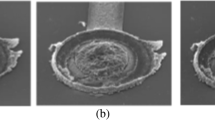Abstract
Stress-corrosion crack propagation in U-4 1/2 wt%Nb has been monitored with crack-opening displacement and acoustic-emission techniques. Excellent correlation was obtained between the direct crack-velocity measurements and the emission count rate at all stress intensities. The data also show that, as the cracking velocity increases, the counts per unit area of new crack surface increase. The results of the investigation show the feasibility of acousticemission detection techniques as a useful stress-corrosion testing tool.
Similar content being viewed by others
Abbreviations
- b :
-
specimen thickness
- b n :
-
specimen thickness at root of side grooves
- E :
-
modulus of elasticity
- K :
-
stress intensity
- K IC :
-
plane-strain fracture toughness
- K ISCC :
-
plane-strain stress-corrosion-cracking threshold
- P :
-
load
- W :
-
specimen length from the load line
- da/dt :
-
crack velocity
- dN/dt :
-
emission rate
- dN/dA :
-
emissions per unit area of crack growth
References
H. L. Logan, The Stress Corrosion of Metals, Wiley, New York, 5–7 (1965).
T. P. Hoar andJ. G. Hines, “Stress Corrosion Cracking and Embrittlement,”Stress Corrosion Cracking of Austenitic Stainless Steels in Aqueous Chloride Solutions, Wiley, New York, 107–125 (1956).
A. J. Forty, “Physical Metallurgy of Stress Corrosion Fracture,”The Initiation and Propagation of Cracks in the Stress Corrosion of α-Brass and Similar Alloys, Interscience, New York,990114 (1959).
N. J. Magnani, “Stress Corrosion Cracking of Mulberry,”Corrosion,26 (10),406–408 (1970).
N. J. Magnani, “The Effect of Chloride Ions on the Cracking Behavior of U/7.5wt%Nb/2.5wt%Zr and U/4.5wt%Nb,”J. of Nuclear Mat. 42 (3),271–277 (1972).
N. J. Magnani, “The Effects of the Environment on the Cracking Behavior of Selected Uranium Alloys,” SCR 72-2661 (1972).
H. R. Smith, D. E. Piper and F. K. Downey, “A Study of Stress Corrosion Cracking by Wedge-Force Loading,” The Boeing Company, D6-19768 (1967).
H. L. Markus, Private communication, North American Aviation Center, Thousand Oaks, CA (Jan. 1970).
H. L. Markus andG. C. Sih, “A Crackline-Loaded Edge-Crack Stress Corrosion Specimen,”Engineering Fract. Mech.,3 (4),45–461 (1971).
K. D. Boultinghouse, “Stress Corrosion Environmental Load Frame and Instrumentation,” Sandia Laboratories SC-DR-710845 (1971).
Author information
Authors and Affiliations
Rights and permissions
About this article
Cite this article
Magnani, N.J. Acoustic emission and stress-corrosion cracking of U-4 1/2 wt%Nb. Experimental Mechanics 13, 526–530 (1973). https://doi.org/10.1007/BF02322341
Issue Date:
DOI: https://doi.org/10.1007/BF02322341



